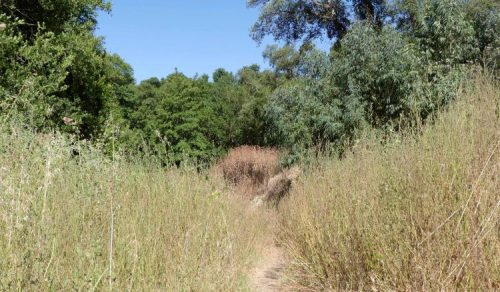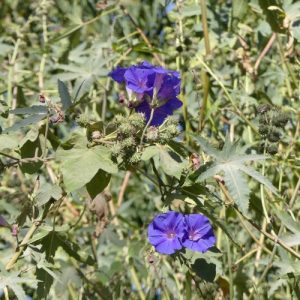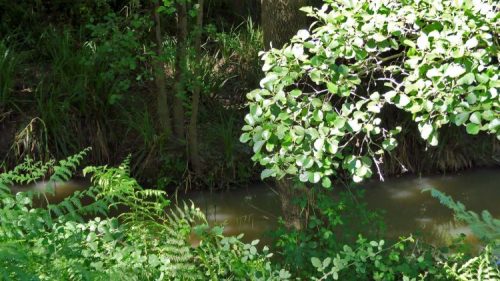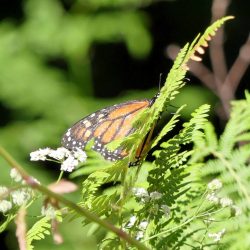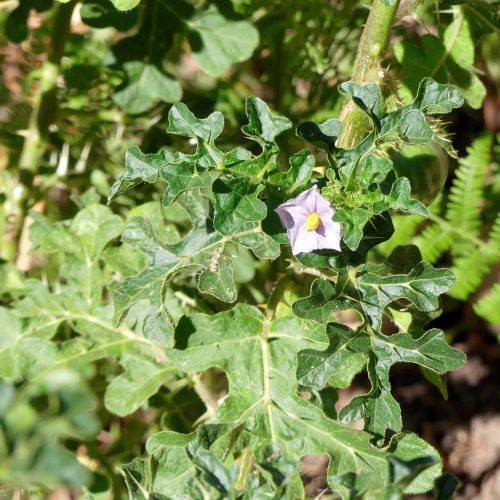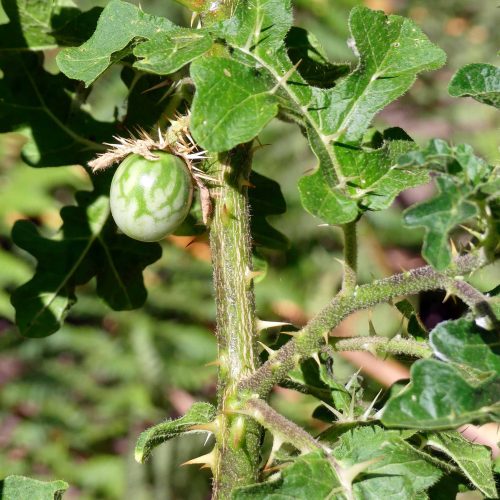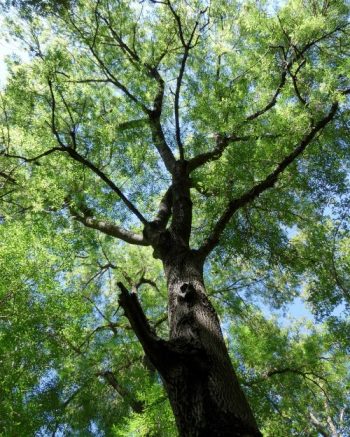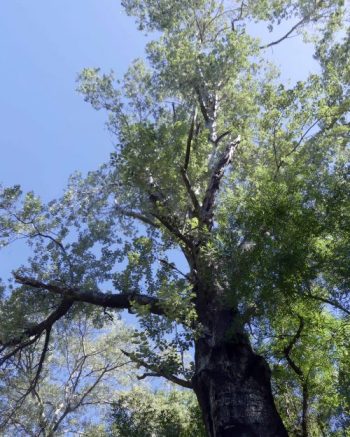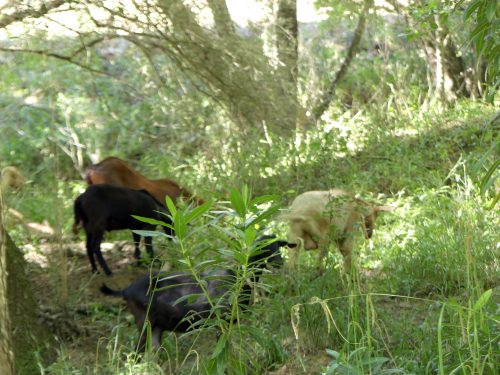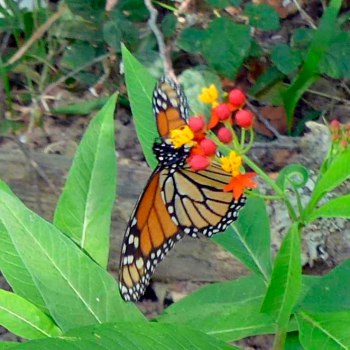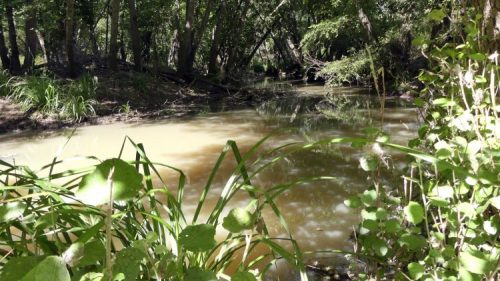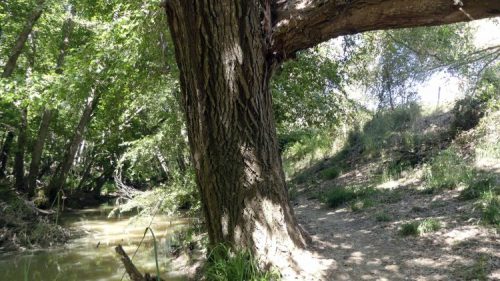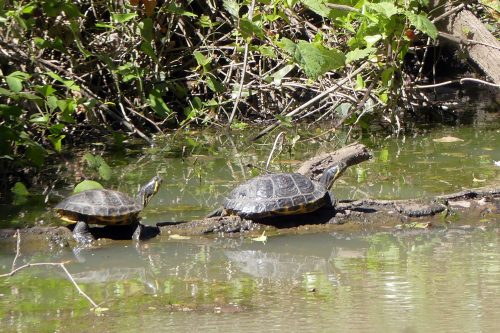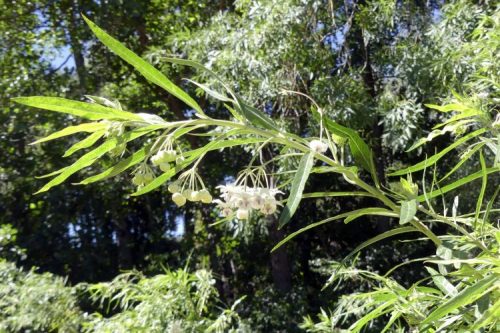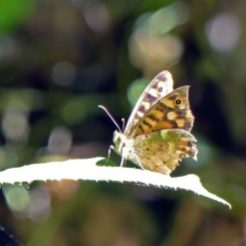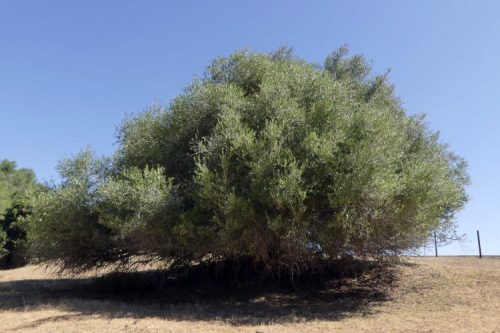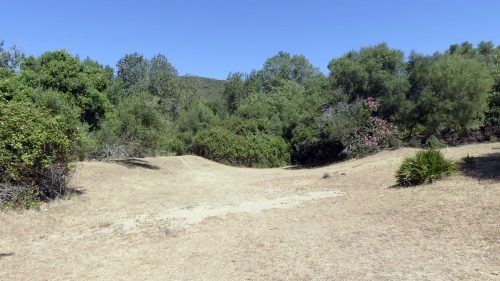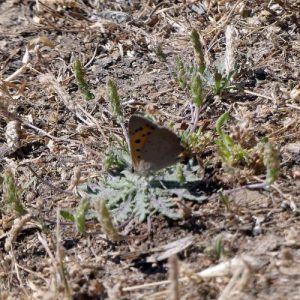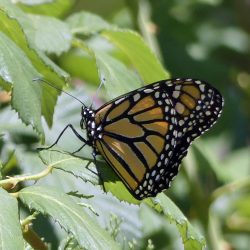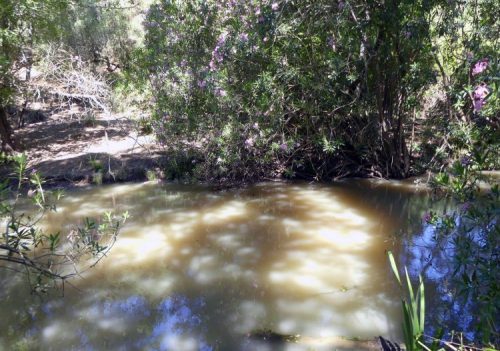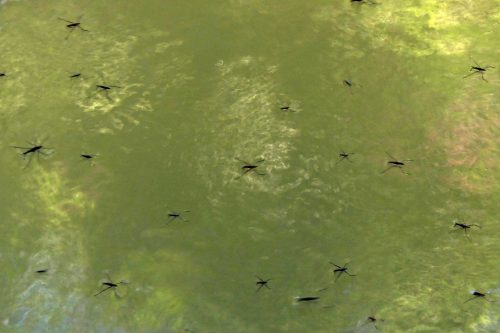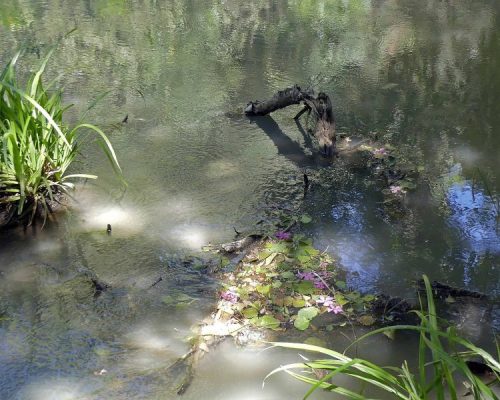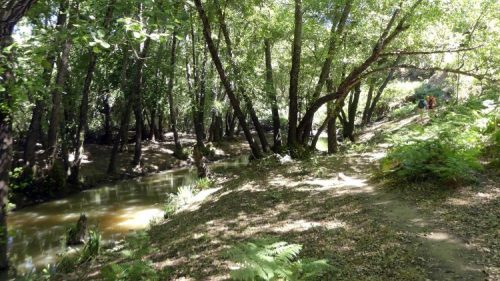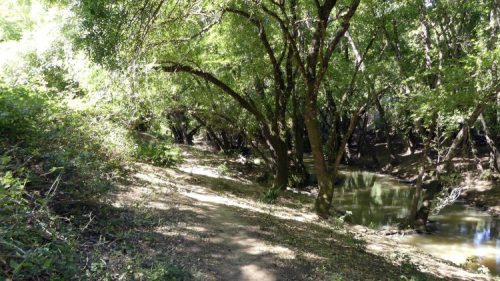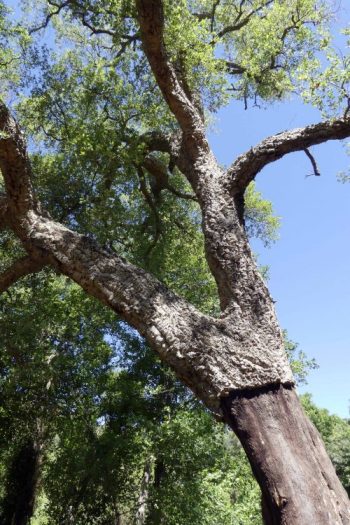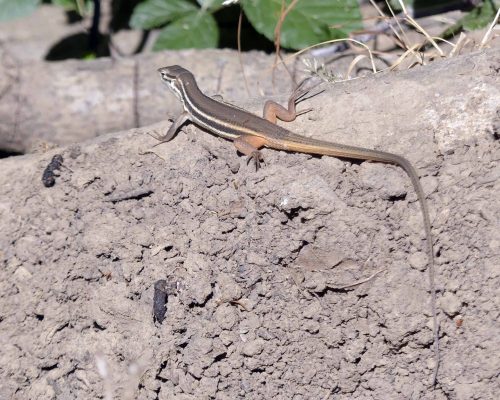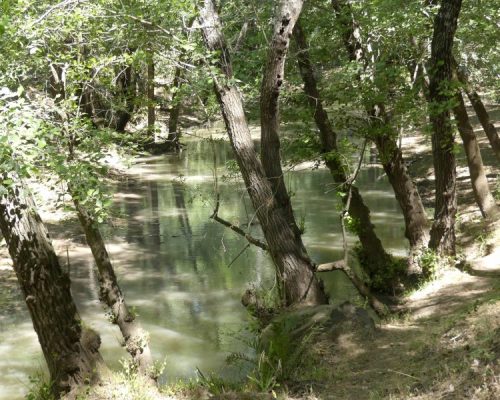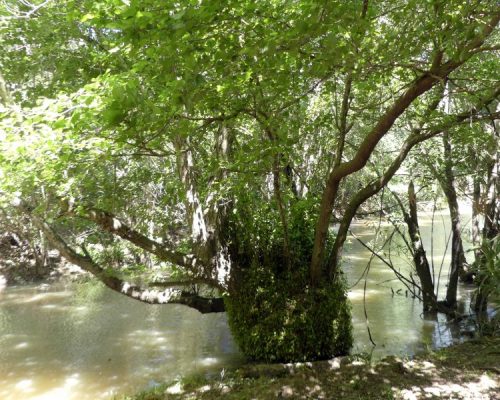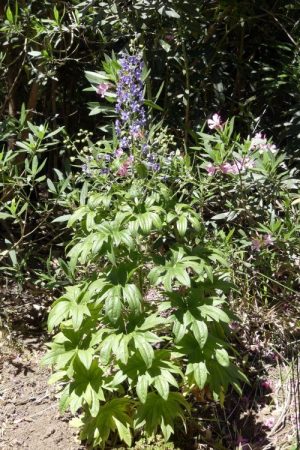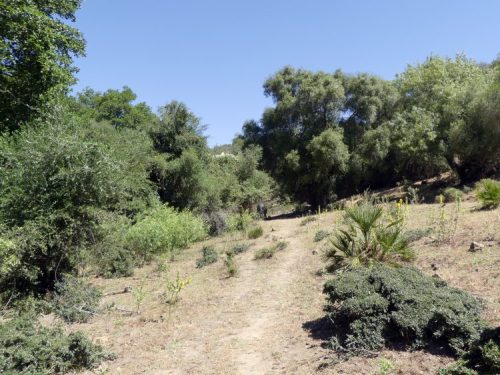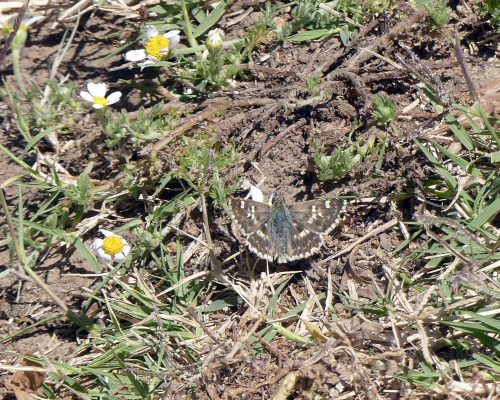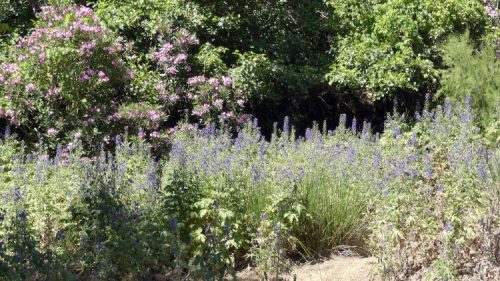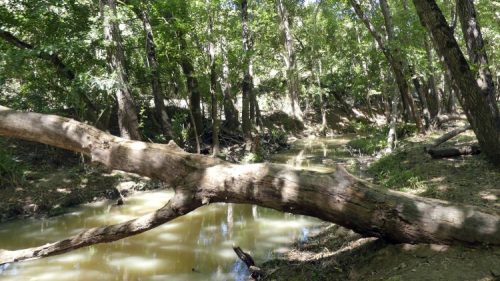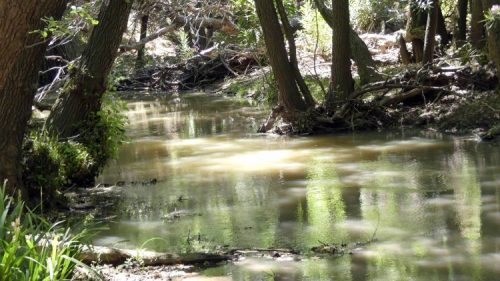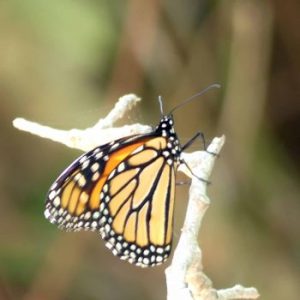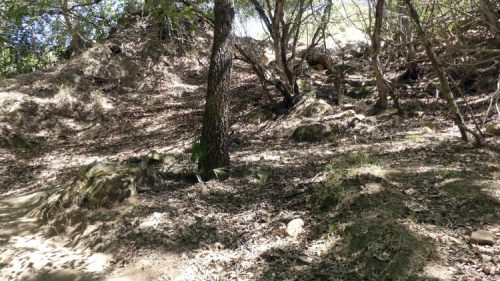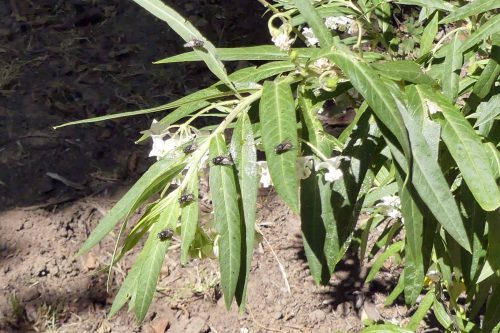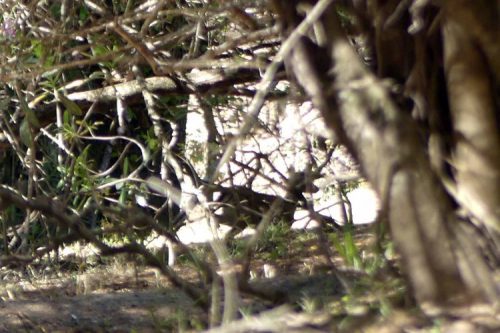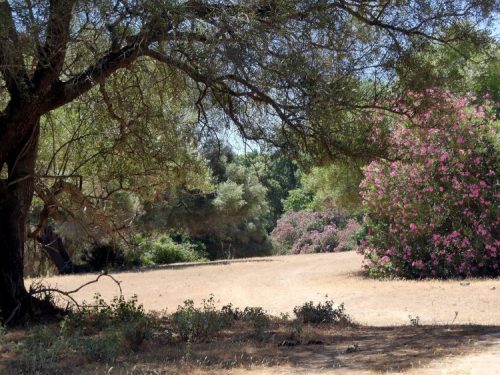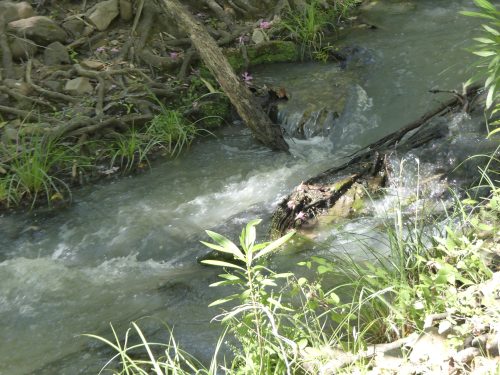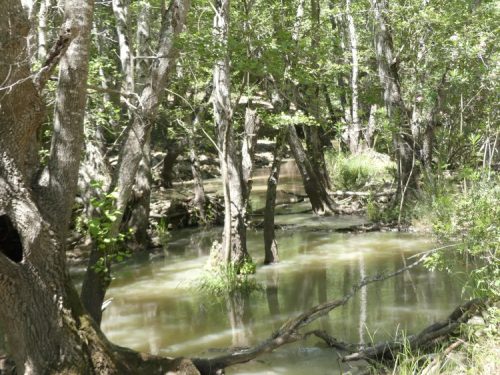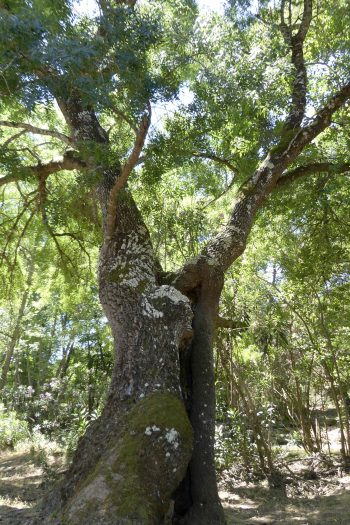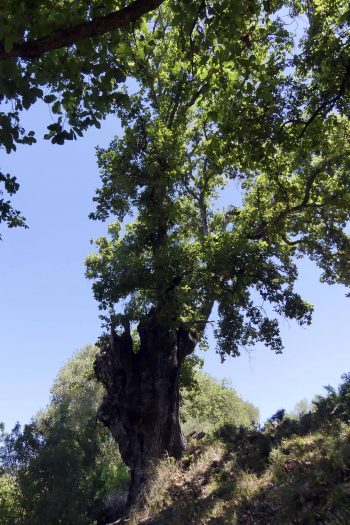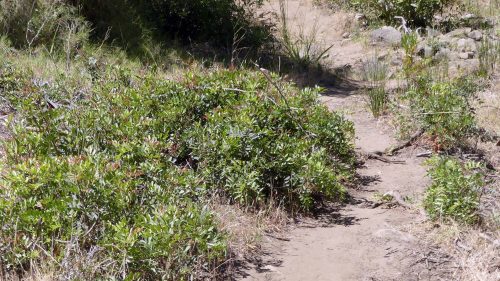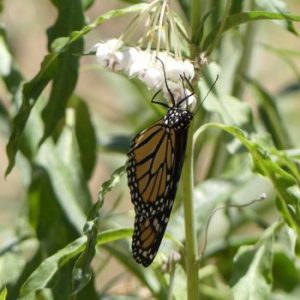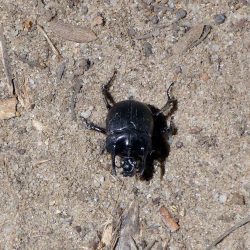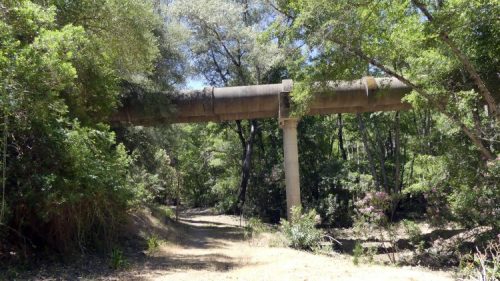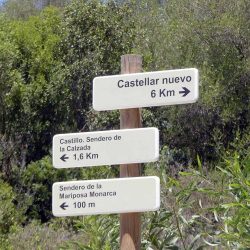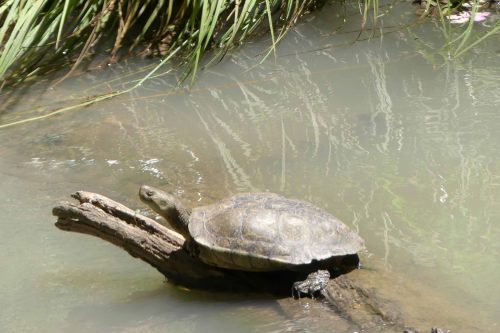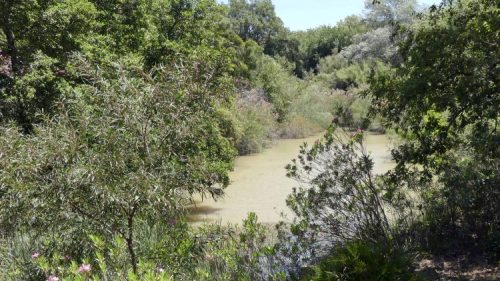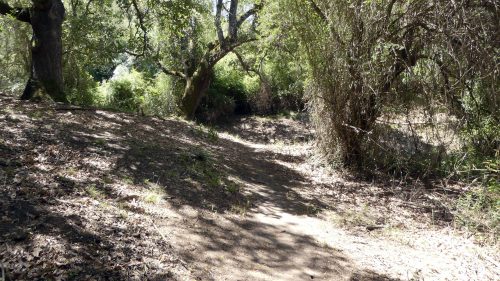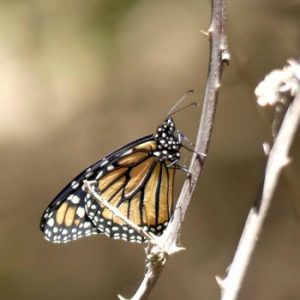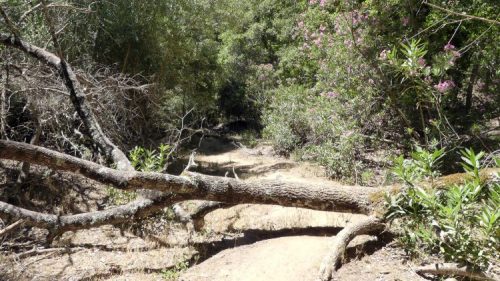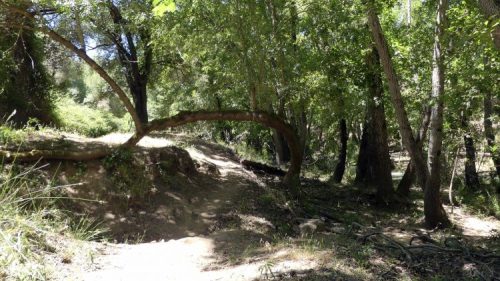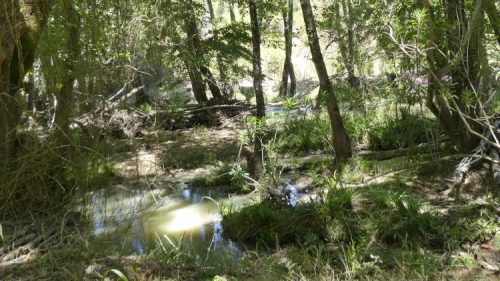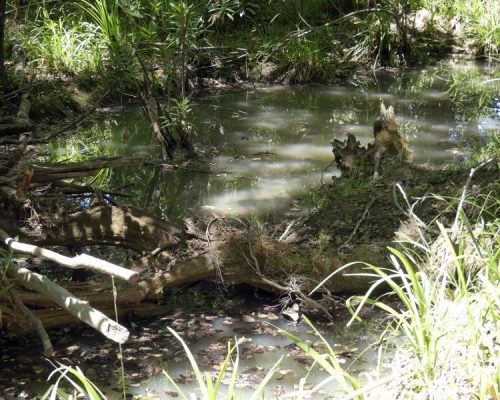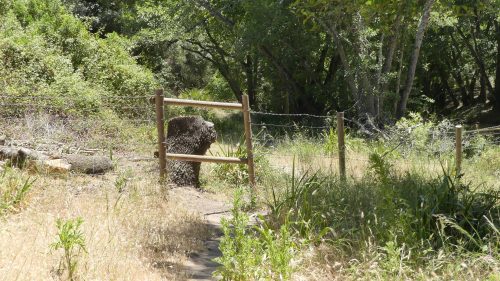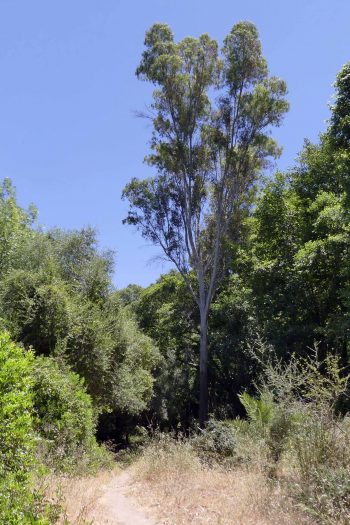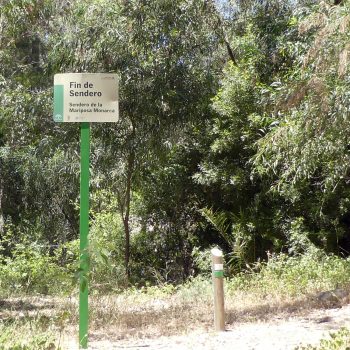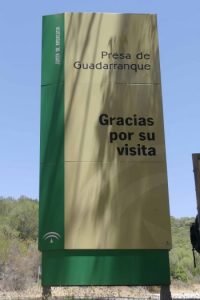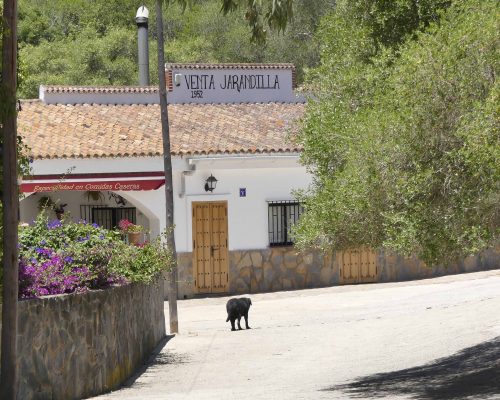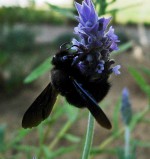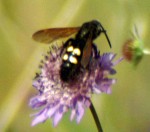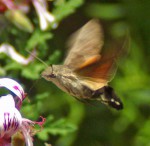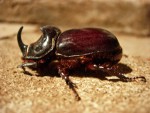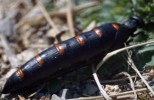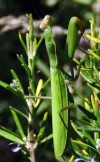June 11th 2019
This morning I set off with three friends to walk a trail new to me, intriguingly called “Sendero de la Mariposa Monarca” or Trail of the Monarch Butterfly. This is a fairly newly established trail that gives the opportunity to walk through some old mixed woodland along the banks of the rio Guadarranque, in the company of Monarch Butterflies. I’m not sure what to expect, but I’m sure it will give a new perspective to an area we know quite well, known to us as La Almoraima.
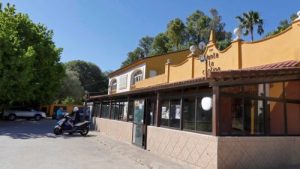 10.40 – We arrived at Venta de la Cantina, which is where we have decided to start our walk. The plan to have coffee and tostada for a late breakfast was disappointingly scuppered, as being a Tuesday the venta was closed for business. It was already very warm though, so maybe just as well we didn’t hang about; it would be a longish walk and I had to admit, highly likely to be slowed down by me stopping to take photographs.
10.40 – We arrived at Venta de la Cantina, which is where we have decided to start our walk. The plan to have coffee and tostada for a late breakfast was disappointingly scuppered, as being a Tuesday the venta was closed for business. It was already very warm though, so maybe just as well we didn’t hang about; it would be a longish walk and I had to admit, highly likely to be slowed down by me stopping to take photographs.
 A sign on the far side of the car park points us in the direction of the beginning of the walk, along a dusty narrow track through tall rapidly drying vegetation.
A sign on the far side of the car park points us in the direction of the beginning of the walk, along a dusty narrow track through tall rapidly drying vegetation.
Still green is a big sprawling Castor Oil Plant bearing round prickly fruits – as yet unripe, through which is twining the lovely bindweed, Ipomoea tricolor – so aptly known as Heavenly Blue.
Another flash of blue on the path catches my eye – the opened wings of a Blue-winged Grasshopper as it leap-flies out of the way. Such a clever strategy – a potential predator strikes at a brown insect, then confused by the sudden flash of colour as it flies away, turns its attention to looking for a blue one. On the drying head of a Wild Carrot, another insect that uses colour as protection – a Striped Shieldbug, or Minstrel Bug, whose black and red stripes warn that it does not taste good.
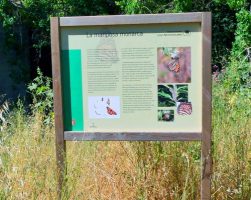 10:53- I’m already lagging behind so speed up to find my friends reading a board bearing information about the Monarch butterfly. It’s in Spanish of course, but roughly translated, this is some of what it says:
10:53- I’m already lagging behind so speed up to find my friends reading a board bearing information about the Monarch butterfly. It’s in Spanish of course, but roughly translated, this is some of what it says:
The Monarch Butterfly-Danaus plexippus, the biggest and one of the most beautiful butterflies found in this area, is probably best known for the great migration of thousands of kilometres it undertakes, flying from North America to winter in a small part of Mexico, where they may gather in their millions.
The only breeding populations on the European continent occur in the area around the Strait of Gibraltar, where its presence has been documented since 1994. Here on the banks of the Rio Guadarranque, on the way to Castellar de la Frontera, we can watch the flight of the big Monarchs, which have a wingspan of some 10cm, as they hover around the plants on which they feed……
10:57 – A first sighting of a beautiful Monarch butterfly
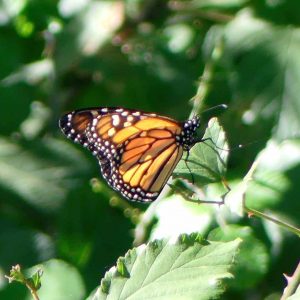 and a first glimpse of the river. I don’t know this river, but I would say that its water level is already quite low – much of the water brought by this small river is contained by a dam and stored in the nearby reservoir, Embalse Guadarranque. What we are seeing here is the depleted final stretch of the river that will soon reach its emptying point into the Mediterranean Sea at Algeciras Bay. The water is a milky cloudy grey-brown colour and hardly to be moving. Bracken and brambles grow close to the water and the branch of an Alder tree hangs low over it. Entering into the woodland beautiful tall Alder trees give already-welcome shade from the rapidly increasing heat.
and a first glimpse of the river. I don’t know this river, but I would say that its water level is already quite low – much of the water brought by this small river is contained by a dam and stored in the nearby reservoir, Embalse Guadarranque. What we are seeing here is the depleted final stretch of the river that will soon reach its emptying point into the Mediterranean Sea at Algeciras Bay. The water is a milky cloudy grey-brown colour and hardly to be moving. Bracken and brambles grow close to the water and the branch of an Alder tree hangs low over it. Entering into the woodland beautiful tall Alder trees give already-welcome shade from the rapidly increasing heat.
11:03-Another Monarch, this one half-hidden behind a bracken frond.
11:07- The shade from the trees was short-lived and we are into a cleared space where the ground is hard and dust-dry; grass is dry and bleached, but Bracken is still vibrantly green.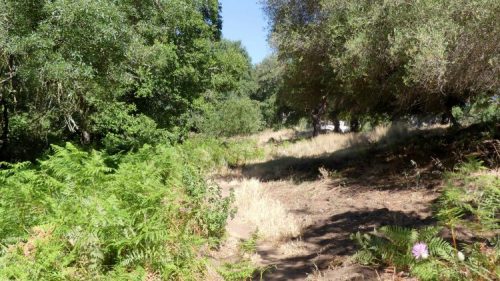 I spot a large Apple of Sodom plant. This very poisonous plant has pale purple flowers that resemble those of Nightshades and fruits, currently green that look like small unripe tomatoes.
I spot a large Apple of Sodom plant. This very poisonous plant has pale purple flowers that resemble those of Nightshades and fruits, currently green that look like small unripe tomatoes.
11:15 – We meet some glorious trees – this one is an Ash – Fraxinus sp– Fresno in Spanish, a species sometimes found growing near small streams and springs as well as in larger river valleys.
Nearby is a White Poplar or Aspen, its leaves and bark silvery against the clear blue sky.
11:25 – We hear the gentle clanging of bells, warning us that we are about to encounter animals. It’s very common to meet domesticated animals when out walking in woods, most often grazing cows, who may look up to see whose passing before resuming their eating, but today it was a small herd of foraging goats. They were on the opposite river bank, so not chomping on the vegetation of this conserved area. I wondered if they had been deliberately let loose to do a bit of conservation grazing on the undergrowth.
11:27 – A Monarch feeding on an orange-flowered Tropical Milkweed.
Not native to Europe, many of these plants, which flower from March through to December, have been planted here to meet the needs of the butterflies. The information board explained that Milkweeds or asclepias, poisonous to the majority of herbivores, are the host plants for Monarch caterpillars. As they eat, the insects absorb poisonous substances from the plant, making them poisonous too. The black and yellow colours of the caterpillars and orange of the adults warn off potential predators. Once the flowers are finished, adult butterflies will take nectar from other flowers.
11:31- The path closely follows the river for a stretch, going around a huge Alder tree with deeply fissured and textured bark. Some old cones remain on the branches, settling any doubts we may have had about the species.
11:36 – Two Striped-neck Terrapins bask in the sun on the partially-submerged branch of a fallen tree. The water looks to be quite shallow here.
11:37 – A tall specimen of another milkweed species, this one is Gomphocarpus physocarpus which has a number of common names, but I’m going for the pretty and polite one of Swan Plant.
11:38- A patch of recently dug-over earth has a clump of a white-flowered plant growing in it that again looks to have been deliberately planted. A female Common Blue was happily taking nectar from it, whatever it is and however it got there. Nearby a Speckled Wood, looking a bit battered basked on a bramble leaf.
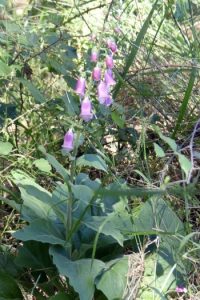 11:41- I was surprised to see a Foxglove flowering here. They are a native species found in places in the Alcornocales woodlands, but as there was only the one plant I wondered if it had been planted to encourage it to establish, or perhaps to re-establish here.
11:41- I was surprised to see a Foxglove flowering here. They are a native species found in places in the Alcornocales woodlands, but as there was only the one plant I wondered if it had been planted to encourage it to establish, or perhaps to re-establish here.
11:42 – The trail leaves the shade of the woodland and takes us along its edge where a simple post and wire fence marks a boundary. Here growing is one of the biggest, healthiest-looking Olive tree I think I have ever seen. Its shadow, almost perfectly matching the shape of the tree shows the sun must have been almost directly above us.
We stay out in the open for a while, walking across the undulating ground of a cleared area.
Having fallen behind again, I caught up with the others who were standing peering into a huge bramble bush. They had heard a Nightingale singing briefly from within it, but although it kept up contact calls, it proved impossible to locate. But, it was definitely a Nightingale, qualifying this one to add to my list of ‘Nightingale Trails’!
11:45- I’m quickly distracted again by a Small Copper butterfly sitting in the centre of a Buck’s-horn Plantain plant.
11:47- A pristine Monarch perfectly posed on a leaf
It was hot out there away from the shade of the trees, so it’s a relief when the path picks up the riverside once again. Large Oleander shrubs, smothered with lovely pink blossom bring an almost-tropical feel to some parts of the river, especially where the water appears still and calm.
Not all is calm though, Pond Skaters skitter about frantically , disturbing the peaceful surface.
11:55 – A peaceful photogenic ‘Zen’ scenario: a submerged fallen tree disturbs the calm flow of the milky grey–green water, blurring deep reflections into patterns textured by delicate ripples. Leaves and fallen Oleander petals have collected together and are framed by a gracefully curving branch and elegant Iris leaves, forming a colourfully artistic arrangement that reminds of a Japanese painting.
Back on track and a section of track close to the river that is in lovely dappled shade, but which is quite uneven and awkwardly sloping
I stop briefly and take a picture looking back the way we have come along the same stretch.
11:57- At the water’s edge more distractions I can’t resist. I watch a darkly coloured damselfly until it settles on bracken, then a Hummingbird Hawkmoth as it delicately and adroitly sips nectar from a Tropical Milkweed flower. It’s good to see these ‘alien’ plants are good for other insects too.
12:08- It seems we’ve only walked 1.7km so far, meaning we have another 4.3 km to go to reach the end of the trail.
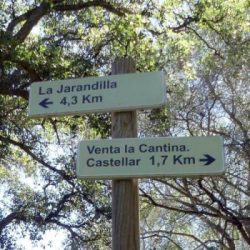 My fault, I’m sure, but there’s been so much to see and I’m sure I won’t be returning here anytime soon….but a bit of speed-walking is probably in order. But first – here’s a Cork Oak which has had most of the bark harvested from its lower trunk that hasn’t grown back.
My fault, I’m sure, but there’s been so much to see and I’m sure I won’t be returning here anytime soon….but a bit of speed-walking is probably in order. But first – here’s a Cork Oak which has had most of the bark harvested from its lower trunk that hasn’t grown back.
And a smallish Large Psammodromus Lizard, beautifully coloured, that scrambled up a mound of earth and had a quick sunbathe on a log at the top.
A line of Alders lean in over the water; the path passes very closely behind them: won’t people walking on it further erode their supporting earth?
Another Alder that wouldn’t look out of place on the banks of a tropical river. It is already multi-trunked, or branched and the greenery that is growing from what seems to be a thick trunk is more Alder – that could potentially grow to form more trunks or branches.
We’d seen quite a few of these blue-flowered plants that will also have been planted for the Monarchs – I don’t know what they are, but this one looks pretty with pink Oleander blossom.
Out of the woods again and out of sight of the river, we are walking through another clearing with ‘scrubby’ vegetation – Dwarf Fan Palms & thistly Spanish Oyster Plants, and unless I’m mistaken Cotoneaster. Scrub vegetation quickly fills in any spaces absented by trees.
I could have lingered longer here as there were insects to be found, but I could see the girls ahead of me, patiently waiting, so I settled for a black-spotted red beetle, that has no common name but I think is a Mylabris sp., an I’m still trying to find-out what insect on Spanish Oyster Plant flowers
and a Safflower Skipper butterfly
The girls were waiting in a spot where a mass of the blue-flowered plants against a background of pink-flowered Oleander could have been part of someone’s summer garden.
Back to the river; shallow and little more than a slow-moving stream here
12:31- A Monarch clings to a bare twig
The path gets s a bit uneven again here as it passes along a rocky bank
Flies sit in formation on the sticky leaves of a Swan Plant.
Through a tangle of trees and shrubbery we glimpse a movement and stand still to watch a deer grazing. It must have heard or sensed our presence though as it lifted its head, looked in our direction and ran away.
We are back out of the woods and in another wide, clear area of sun-baked ground where a huge Carob tree frames a park-like view of trees and big Oleander shrubs.
A rough section of the path crosses a dry rocky stream-bed, then it smooths out again; the river here has narrowed to little more than a stream which bubbles and foams as it races over rocks and around fallen tree branches.
12:45- Beyond the river widens again & water surrounds trees – it looks primeval; more like a swamp or creek in Florida than an Andalusian river.
A gnarled and misshapen Ash tree, its trunk divided into two. I fancy I can see the shape of a primate in the trunk nearest to me – if I had the time to stop and look at it for a while I’m sure I could and probably would make up several variations on a fairy-tale featuring this characterful tree.
On a bank further along another misshapen old tree, this one an Alder.
Lentisc, or Mastic shrubs have established at the side of the path.
12:58- A Monarch nectaring on a Swan Plant; so pretty
A black beetle scurries across in front of me. He’s big and has two distinctive ‘prongs’ that extend forward either side of his head – he’s a Minotaur Beetle, a type of dung-beetle, so he’s probably out seeking something nice and smelly.
13:03- The path passes beneath two huge pipelines supported on concrete columns that must be carrying water away from the nearby embalse (reservoir).
13:04- Another signpost informs that we still have almost 2km further to walk – it’s taken just over 3 hours to get here.
I should speed up a bit, but there are so many distractions, like this Stripe-necked Terrapin posing so nicely on a log in a patch of milky water that is reflecting overhanging reeds…
13:10- Another shallow and animated section of water that swirls and falls rapidly over rocks and around trees, racing past pretty Oleander
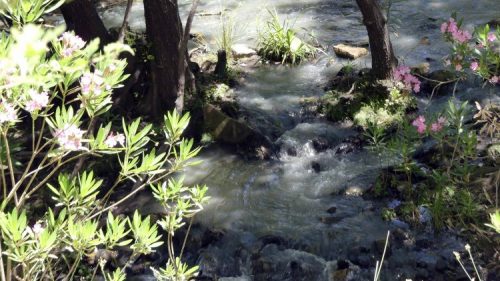 Upstream beyond this moment of watery excitement all is calm – the river is suddenly much wider and deeper, which probably accounts for the apparent speed where it narrowed – we are walking upstream, so looking at the river’s flow almost retrospectively.
Upstream beyond this moment of watery excitement all is calm – the river is suddenly much wider and deeper, which probably accounts for the apparent speed where it narrowed – we are walking upstream, so looking at the river’s flow almost retrospectively.
A huge chunk of rock sits on top of the bank at the side of the path. I can’t help but wonder both how it got there and how long it’s been sitting there. It looks as though it has been roughly cut and shaped, so maybe it was once destined to be part of the Castillo that sits high above where we are walking. Its surface is aged and covered with a patchwork of mosses and lichens. It would take some shifting.
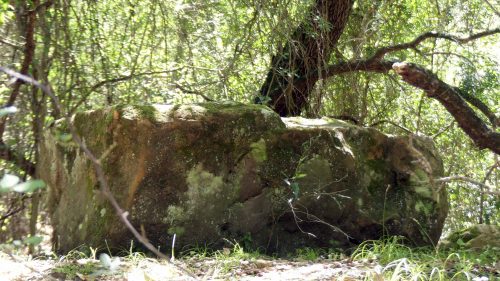 Another section of dry, slippery sloping track needs some concentrated negotiation
Another section of dry, slippery sloping track needs some concentrated negotiation
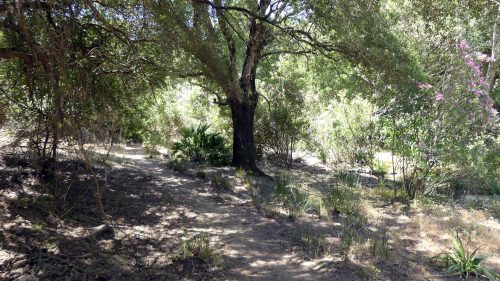 the path is still rough, dry and dusty and lined with what I think is probably Esparto grass.
the path is still rough, dry and dusty and lined with what I think is probably Esparto grass.
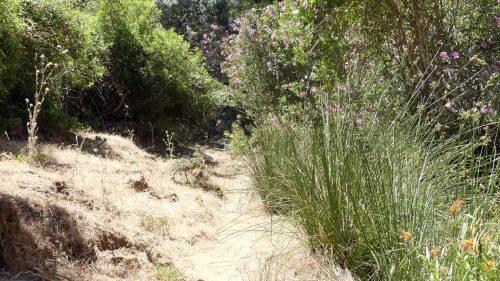 13:25- A Monarch poised on a thorny bramble twig
13:25- A Monarch poised on a thorny bramble twig
More Tropical Milkweed has been planted close to the water where the plants will find more moisture.
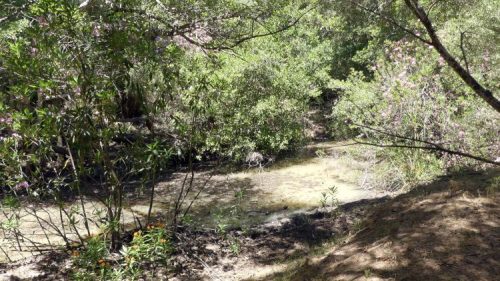 A fallen tree has been left where it fell across the path
A fallen tree has been left where it fell across the path
Another natural bridge where a tree trunk, or branch, has arched over the path. This one is far from dead though and continues to grow, sending up vertical branches.
We see another section of the river where its level and flow is much diminished.
I spy a lovely little Spanish Gatekeeper butterfly probing for nectar in one of a very few remaining flowers on a thistle.
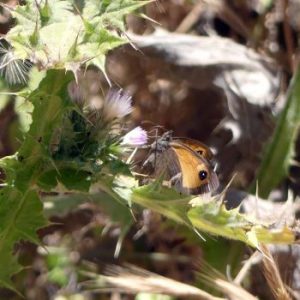 13:38- Less than a kilometre to go!
13:38- Less than a kilometre to go!
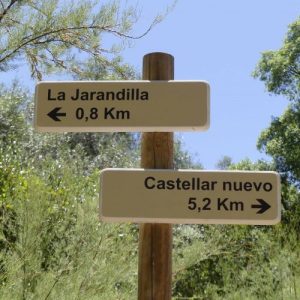 Plenty of time to squeeze in a few more photographs, like this one showing the interesting bark on a multi-trunked Alder tree.
Plenty of time to squeeze in a few more photographs, like this one showing the interesting bark on a multi-trunked Alder tree.
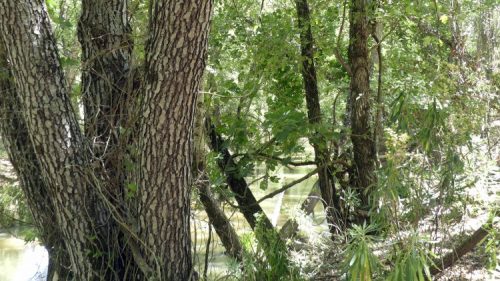 13:39- A Monarch on a bramble – I’d been hoping to catch at least one with its beautiful wings open; this was close but not quite there.
13:39- A Monarch on a bramble – I’d been hoping to catch at least one with its beautiful wings open; this was close but not quite there.
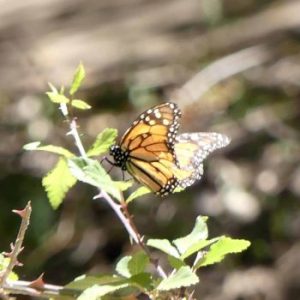 We are on a scenic length of trail, back amongst trees and following a section of river that is wide and flowing gently.
We are on a scenic length of trail, back amongst trees and following a section of river that is wide and flowing gently.
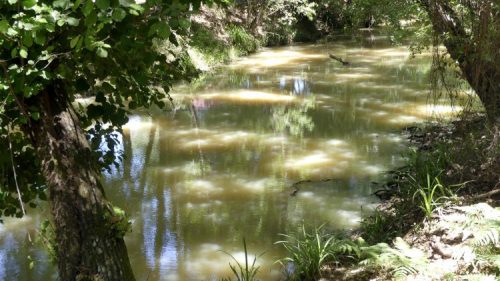 There is bright green ferny bracken on the riverbank and
There is bright green ferny bracken on the riverbank and
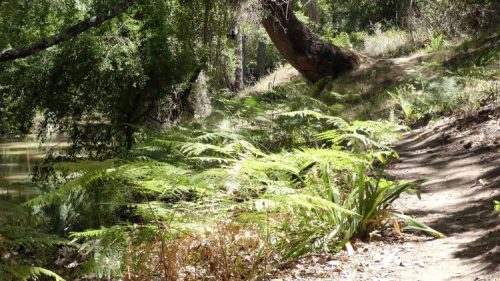 clumps of Iris foetidissima – whose Latin name always sounds so much prettier than the plant’s common name of ‘Stinking Iris’. There’s quite a lot of it growing here and it reminds me of my home woodland patch in North Wales, where interestingly the plant is at a similar stage of growth, having produced its distinctive big seed pods that are still unripe and green.
clumps of Iris foetidissima – whose Latin name always sounds so much prettier than the plant’s common name of ‘Stinking Iris’. There’s quite a lot of it growing here and it reminds me of my home woodland patch in North Wales, where interestingly the plant is at a similar stage of growth, having produced its distinctive big seed pods that are still unripe and green.
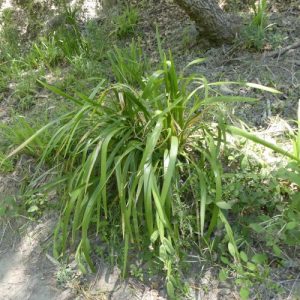 The river narrows again and is partially dammed by a fallen tree
The river narrows again and is partially dammed by a fallen tree
We cross over a deep gully which looks like it channels a significant stream into the river in wetter months and is fitted with a crossing aid – a sort of fence that allows you to cross by walking sideways along the lower rail while holding on to the upper one.
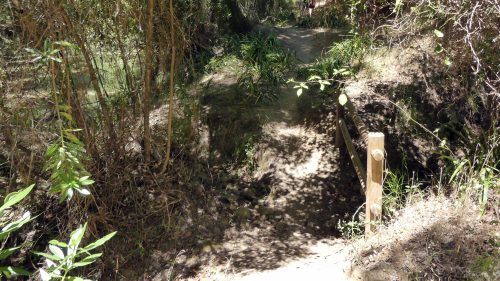 Once again the river is wider and is edged with a neat line of Alders.
Once again the river is wider and is edged with a neat line of Alders.
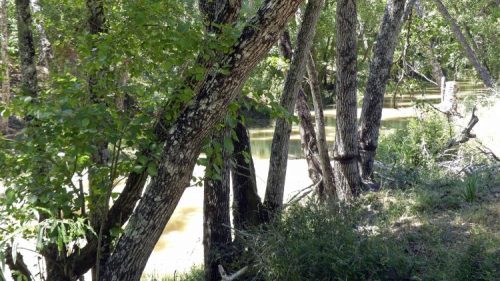 13:52 -We had heard the calls of Bee-eaters flying overhead several times during our walk, but now in a clear space where power lines cross high above the river we had lovely views of one of these gorgeous birds perched on a cable scanning around for potential prey, tilting its head to look above and below.
13:52 -We had heard the calls of Bee-eaters flying overhead several times during our walk, but now in a clear space where power lines cross high above the river we had lovely views of one of these gorgeous birds perched on a cable scanning around for potential prey, tilting its head to look above and below.
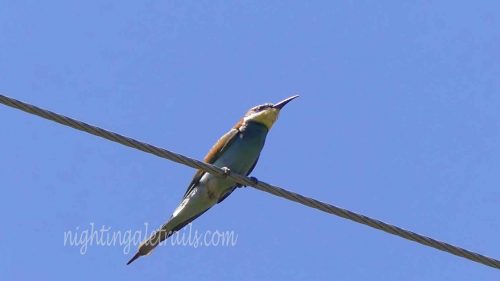
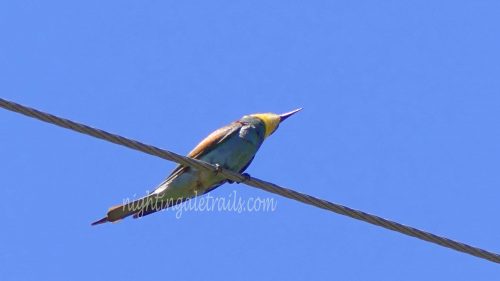 We reach a post and wire boundary fence which is fitted with a wooden-framed opening to allow people to pass through but which would deter larger animals such as Wild Boar.
We reach a post and wire boundary fence which is fitted with a wooden-framed opening to allow people to pass through but which would deter larger animals such as Wild Boar.
The path is now bordered on both sides by long grass; on the shadier and presumably damper river side it is still fairly green whilst on the other side it is already bleached and dry.
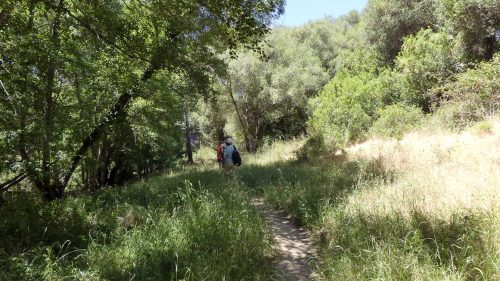 13:57-And still there are Monarchs to be seen, this one nectaring on the flowers of a Tropical Milkweed.
13:57-And still there are Monarchs to be seen, this one nectaring on the flowers of a Tropical Milkweed.
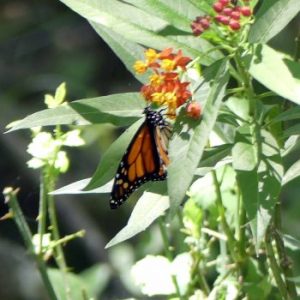 13:58- The road bridge that crosses the river at La Jarandilla is in sight.
13:58- The road bridge that crosses the river at La Jarandilla is in sight.
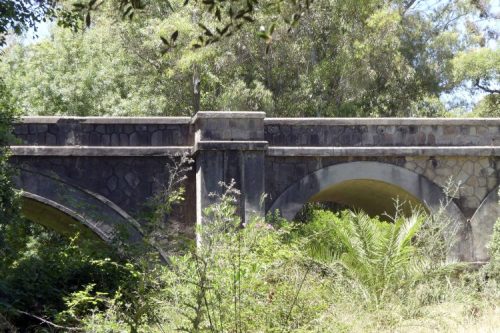 Just one more dry gully to cross and we’re almost at the end of our walk.
Just one more dry gully to cross and we’re almost at the end of our walk.
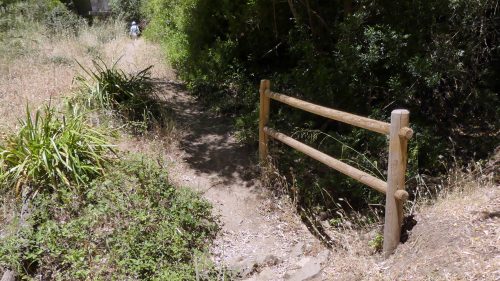 13:59- A tall Eucalyptus tree marks the end of the trail
13:59- A tall Eucalyptus tree marks the end of the trail
And there is an official signpost in case we hadn’t realised we had made it
14:00 – What a shame the Venta Jarandilla is also closed on Tuesdays. I have some very happy memories of pre-walk breakfasts and post-walk coffee or lunches enjoyed there in past years.

